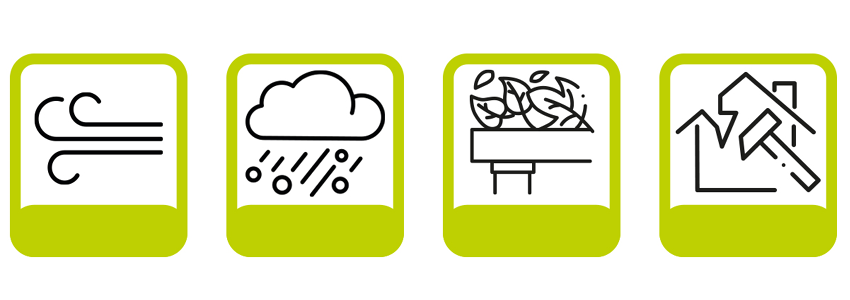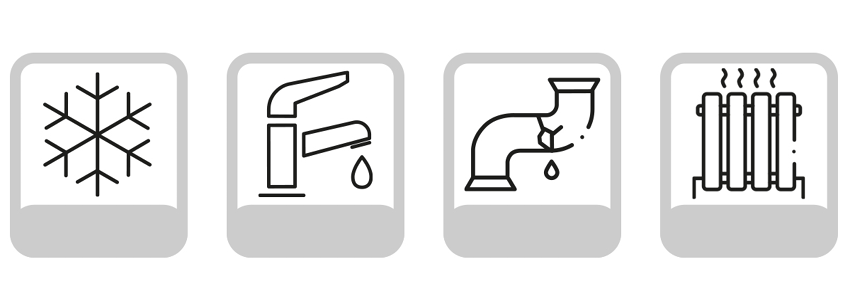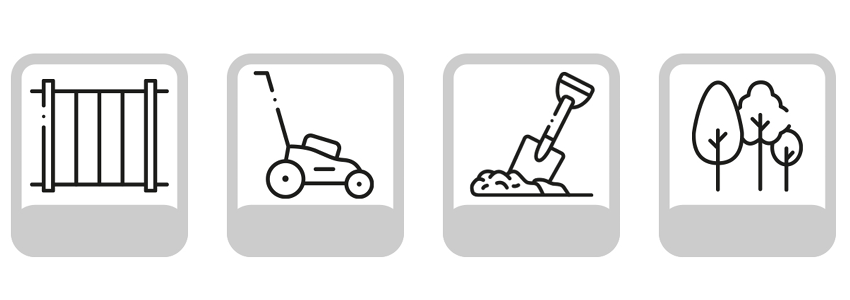

The complete guide to spring property maintenance for landlords
As the harsh winter weather subsides and spring begins to bloom, it’s the perfect time to check your property for any damage that may have resulted from the damp, cold and frosty winter weather. Spring is a great opportunity for landlords looking to inspect their property as the weather not only becomes milder, but days also get longer, making it easier to check on your property’s health.
Identifying any issues early on can help prevent your property suffering from extensive damage that could cost significant amounts of time and money to resolve if left to fester. Although no property is exempt from the occasional maintenance issue - after all the property is in daily use - following some simple and easy guidance can help you to avoid larger issues from developing in the first place.
In this guide, NRLA insurance partner, Total Landlord, run through their S P R I N G steps - Structure – Pipes – Inspect – Next time – Garden – along with tenant tips, to keep your property well maintained this season.
Structure
Strong winds, damp conditions and cold temperatures can wreak havoc with your property, and spring is the first real opportunity to check the property’s structure after winter. Sometimes landlords see property maintenance as confined to what is going on inside the building. But it is just as important to check on your property’s structure, as well as any internal maintenance that might be needed.

Roof damage
Storms and strong winds can cause damage to your roof. This may include exposing cladding, dislodging tiles or even worse, removing
them completely. Leaks can often occur, causing problems in loft spaces and attics, as well as affecting rooms lower down in the
property and potentially damaging soft furnishings. Inspecting the roof should be a priority during your property’s first post-winter check. It’s a good idea to also inspect the guttering as strong winds can easily dislodge even the strongest of guttering. This is especially important during the spring, as any disruption in guttering or build-up of debris could cause a leak or blockage that would be unwelcome come April showers.
TIP
Inspecting any area of your property, including the roof, should be done safely, with care and the right equipment. If you are in any doubt as to whether you can carry out the maintenance yourself be sure to seek guidance and advice from a qualified contractor.
Subsidence
It is also important to check for any signs of subsidence in your property. Look for cracks in the walls, ceilings and brickwork. Identifying and treating subsidence sooner rather than later is the best way to stop the issue from escalating. While the most obvious signs of subsidence are cracks, the majority of cracks in a property are as a result of settlement, which is not a huge concern. Do however look out for more specific signs of subsidence such as:
- Diagonal cracks that increase in width the further away they are from the ground
- Cracks that are visible both internally and externally (and are at least 3mm wide and as thick as a 10p coin)
- Cracks in the brickwork or plasterwork around doors and windows
- Cracks between different areas of the property, such as the main building and an extension
- Wrinkled wallpaper located at the wall and ceiling joins
- Doors and windows that stick as the frames are misshapen
There are three potential causes of subsidence that could be exacerbated during the spring when temperatures rise and vegetation begins to grow again after winter. These are:
- Shrinkage of clay soils as the temperature rises in warm weather
- Defective drainage that can cause erosion of the surrounding soil
- Increased growth of trees and vegetation situated too closely to the property
Regular maintenance of your property and garden can help to prevent, identify and treat issues such as subsidence.
Wood rot
Another key area of concern when inspecting your property
should be wood rot. Over the wet winter weather, it is not uncommon for protective paints or seal to come away. When this is coupled with warming temperatures, it can cause wood to rot. Treat any affected areas as soon as possible to avoid further deterioration.
TIP
Don’t forget to clear your foundation vents! These vents may have collected debris over the winter months that will limit the amount of ventilation your property receives. A lack of airflow in this area could result in problems with wood rot.

Pipes
Cold winter weather can lead to pipe damage, therefore in any spring maintenance it’s a good idea, if you have outdoor taps, to turn them on to assess the volume of water that is coming out. Outdoor taps are especially vulnerable to temperature changes. While problems involving pipework are often serious due to the volumes of water involved, they are also fixable if the property is sufficiently maintained. A reduced flow or trickle of water from your taps could signify that your pipes have become damaged or frozen during the cold winter weather. Other potential issues that you may encounter with pipes include jammed valves, dripping taps or even worse - a burst pipe. It is important to assess any pipe issues in a timely fashion to minimise significant property damage. Spring is also a great time to contact a professional plumber to give your property a spring health check, especially when coming out of a cold winter. Prevention is always better than cure.
Frozen pipes
If your pipes are frozen you can attempt to unfreeze them by using a space heater, heat lamp, or hair dryer to thaw out the pipe. Alternatively, you could wrap them with thermostatically controlled heat tape as an effective way to thaw a particularly troublesome spot.
TIP
Make sure you communicate the location of the property’s stopcocks to your tenants. In the event of a burst pipe in the property, turning off the stopcock can be a quick and effective way to mitigate against extensive property damage.
Removal
Removal of debris
It’s a good idea to remove any debris around your property during a spring inspection, by getting rid of any leaves, twigs or rubbish
accumulating around the property. This will not only make it more pleasant to look at, but also minimises safety concerns as debris that are left over from winter could be a potential fire hazard if left to dry out over the spring and summer months - dried leaves and twigs left in piles in the garden or guttering make the perfect kindling, which only takes one spark to result in a fire.
White goods and appliances
Spring is also a good opportunity to check over your white goods and appliances and remove and replace any that are not working correctly. Don’t forget to check the vents of washing machines and tumble dryers, as they can often become clogged up by fabric particles and dust over an extended period of time, especially after heavy use in the winter. Also, don’t forget to check the electric coils behind the fridge for dust build-up which could result in its failure.

Inspection
How often should I carry out a property inspection?
It is important that landlords are conducting regular inspections in line with the tenancy agreement and as stated in their insurance policy. If you are insured with Total Landlord Insurance, inspections need to take place within a month of the tenant moving in and at least every six months to make sure the property is in good working order. Spring is the perfect time to pop by your property to check not only how your property is doing, but your tenants too. A property inspection covers everything from property safety and security, to fixtures, fittings and appliances and the overall cleanliness of the property. Wet and cold winters can be a breeding ground for damp and mould, so assessing and treating this problem quickly can help to prevent further problems for your property and your tenants.
TIP
If you are insured with Total Landlord Insurance, you should carry out property inspections within a month of the tenant moving in and then every six months. Keep records of inspections and make sure tenants sign and date your interim inspection report to agree that they are happy with the findings.
Damp and mould
Damp and mould can be a big problem in properties, especially those with a lack of good ventilation. There is often debate between landlords and tenants about who is responsible for damp and mould in a property. For example, if damp and mould is a result of issues with the property itself - such as poor ventilation or a lack of damp proofing - it is more likely to be an issue for the landlord to resolve. But if the tenant is not ventilating or heating the property properly, the damp and mould could also be caused by the tenant, or perhaps a combination of both. It is not always clear cut who is responsible. Either way, early identification and treatment of the issue is extremely important. It is vital to get on top of damp and mould to prevent its spread and also because of the detrimental, and potentially serious impact, it can have on the health of your tenants. It is especially useful to conduct checks for condensation, damp and mould during a spring property inspection as a build-up of condensation may have resulted in damp and mould accumulation over the winter months. If you suspect a build-up of condensation is causing problems, then advise your tenants to:
- Always leave background heating on in the property during colder months (this may become less of a problem as the weather heats up)
- Inform you if any extractor fans in the property are not working or are blocked (as a landlord you should make sure that there are working extractor fans in areas where moisture and steam may be produced such as the bathroom or kitchen)
- Air the property by opening windows, when it is safe to do so
- Remind your tenants of property safety to avoid any security concerns
- Close off any moisture or steam in a room, for example during and after a bath or shower, to stop it spreading throughout other rooms in the property
- Avoid drying wet clothes on radiators or other heaters in the property
Maintaining an open and transparent dialogue with your tenants when it comes to issues in the property is extremely important to help rectify any problems and prevent long term issues. Why not pass on our tenant top tips and guidance at the end of this guide as a handy way to remind your tenants of good property maintenance practice?
As a landlord, when conducting an inspection, you should always look out for:
- Rising damp – usually caused as a result of breached damp proof coursing in the walls or floor
- Penetrating damp – resulting from rain or water seeping through brickwork or tiles
- External plumbing problems – is there any cracked or weathered piping?
- Blocked guttering
TIP
Your window sills can provide you with a good indication as to whether there are condensation problems in the property. Look out for an accumulation of water droplets and mould development.
Boilers
Despite many people believing that boilers are something to check during the winter months, boiler breakdowns still account for many spring related issues, especially after an intense workout during the cold winter months. Many landlords don’t realise that there is a difference between a boiler safety check and a service. Filters that would be cleaned during a service, but not necessarily during a safety check, could still cause issues for the boiler so it is a good idea to make sure that your boiler has also had a spring clean.
TIP
Why not have your boiler serviced at the same time as the annual gas safety check to prevent such problems?
Boilers and pipes are the cause of many claims so make sure you’re fully covered in the event of any water damage.
Next Time
While you’re carrying out your property inspection, always think one step ahead. What could affect your property in the months to come? Pre-emptive maintenance can keep you one step ahead of problems, leaving your property and your tenants healthier and happier for longer.
No landlord wants unexpected and uninvited guests – pests and insects being no exception. The warm weather of spring can bring with it a number of unwanted guests such as wasps, bees and mice all looking for somewhere they can call home.
Pests can be drawn to your property for a number of reasons including:
- Easy access – pests love an easy access point when they are looking to make a new home. If you spot any potential entry points make sure you cover these sufficiently. For example, investing in some exterior air brick protective covers can prevent pests getting in in the first place
- Warm weather and rubbish – pests can be drawn to a property where waste bins are full and easily accessible. Advise your tenants how best to manage this. For example, keeping bins closed and sealed at all times. As a landlord, you may want to build a storage unit to house your bins if this is an ongoing issue for your property
TIP
If you discover a pest infestation it is a good idea to call a specialist pest removal service to deal with the issue for you. Removing nests, especially those of stinging insects such as wasps and bees, can be very dangerous, but without adequate removal it could be an issue that just keeps coming back.
Property security
In line with the theme of always thinking ‘one step’ ahead also consider whether your property is secure going into the spring and summer. While the cold winter weather meant that tenants were more likely to keep their doors and windows closed, in the warmer months doors and windows will be left open. Break-ins and attempted break-ins are a big headache for landlords and tenants, with opportunistic thieves looking to exploit weakened defences. Carrying out a quick property security check can be extremely useful for preventing any such events.

Garden
Finally, don’t forget any gardens, patios and outside spaces. Gardens are an often neglected area for landlords and tenants during the winter period, leaving them dishevelled and looking unloved come spring. Interestingly, gardens are often one of the most contentious areas between landlords and their tenants so keeping a good eye on the garden can help to mitigate any problems later on in the tenancy.
Whilst it is your tenant’s responsibility to take care of day to day maintenance in the garden, including but not limited to basic weeding and lawn maintenance, some jobs do fall to the landlord. For example, landlords may still be responsible for the maintenance and pruning of any tall trees or shrubs, as these generally require a qualified professional. Branches may have become damaged or dislodged over winter, which can pose a real threat not only to the building and surrounding power lines, but your tenants too. If you notice any over-hanging branches, then it is probably time to give your local tree surgeon a call.
TIP
Make garden responsibilities clear in the tenancy agreement to avoid any confusion with your tenants.
Paving, walls and fences
It’s not just roads that suffer from the effects of the harsh winter weather. It is also important to check on front/back garden paving stones, walls and fences. Uneven and cracked paving stones could be a trip hazard for tenants and their guests, and walls showing cracks and dislodged bricks are also a concern. Minor issues can usually be fixed relatively easily, so spotting any issues early can be a lifeline for landlords. In terms of walls and fences, not only do they pose a risk for your tenants, but they can also signal a breakdown in property security for would-be burglars. Hopping over a fence that used to exist is a lot easier than hopping over one that is adequately maintained and acts as a sizable deterrent.
Preparing for summer
Once you have completed your spring checks you may feel like your work is done. However, property maintenance is an ongoing process. Different seasons bring about their own potential property challenges and so making sure your property has not only been ‘spring cleaned’, but also prepared for the summer months is a worthwhile investment. Keeping open lines of communication between you and your tenants is also a good idea. In this way, should they notice any property maintenance issues they can notify you sooner rather than later, no matter the time of year.
Tenant Tips
While it is a landlord’s responsibility to make sure that their rental property is in good working condition for their tenants, it is also important to seek the help of your tenants when it comes to property maintenance. As a landlord, you may not have constant access to the property, so providing your tenants with top tips as we move into spring can help to keep your property in good working order and encourage them to notify you of any problems with the property before they get worse. Use the acronym S P R I N G to keep your spring property maintenance on track. Print off or email your tenants our spring property maintenance tips for tenants to encourage your tenants to let you know if there are any issues that need dealing with.
TIP
You could always personalise this message further with property-specific top tips or arrange a property inspection with your tenants to check over the property in greater detail. Communication with your tenants is key for a healthy landlord-tenant relationship.
Download the Spring Property Maintenance Tips for Tenants below

